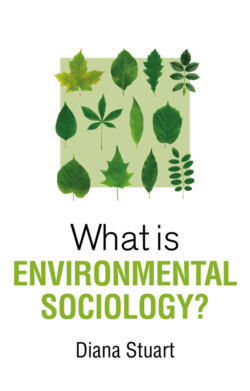What is Environmental Sociology?

Реклама. ООО «ЛитРес», ИНН: 7719571260.
Оглавление
Diana Stuart. What is Environmental Sociology?
Table of Contents
Guide
Pages
Series Title. What is Sociology? Series
What is Environmental Sociology?
Copyright Page
Preface
1 Environmental Sociology: In Uncharted Waters
In Uncharted Waters
Navigating Nature and Society
Public Environmental Sociology in an Age of Crisis
Book Overview
Discussion Questions
Suggested Reading
2 The Social Dimensions of Environmental Impacts
The Role of Science: How Do We Know?
Public Sociology: Exposing Efforts to Undermine Climate Science
Environmental Impacts as Risks and Problems
Public Sociology: Working with Communities, NGOs, and Regulators on Toxins
Environmental Impacts as Crises
The Unequal Distribution of Impacts
Public Sociology: Native American Climate Vulnerabilities
The Social Dimensions Matter
Discussion Questions
Suggested Reading
3 Examining Drivers of Environmental Impacts
Global Drivers: Beyond Population Growth
Public Sociology: Identifying Drivers of Carbon Emissions
Individual and Household Drivers
Public Sociology: Confronting Consumer Culture and Materialism
Structural Drivers
Public Sociology: Exposing and Politicizing Structural Drivers
The Role of Ideology
Seeing the Whole Picture
Discussion Questions
Suggested Reading
4 Identifying Solutions
The Big Picture
Individual Solutions
Public Sociology: The Limits of Precautionary Consumption
Modernization
Reflexive Modernization
Ecological Modernization
Public Sociology: The Renewable Energy “Transition”
Structural Changes
Public Sociology: Targeting Super-Polluters
Toward a New System?
We Cannot Be Radical Enough
Discussion Questions
Suggested Reading
5 Moving Forward
Social Movements and Social Change
Public Sociology: Pushing Forward a Climate Justice Agenda
Growing Momentum for Change
Moving Forward in Environmental Sociology
Doing the Necessary Work
Discussion Questions
Suggested Reading
References Cited
Index
POLITY END USER LICENSE AGREEMENT
Отрывок из книги
DIANA STUART
There is tremendous work to be done to correct our current trajectory and steer a course toward the best future possible. Even if this path is through uncharted waters and the challenges are daunting, there is a moral imperative to keep going. We are also in an exciting moment in history, where public opinions have shifted and social movements are challenging the current system. At the same time, powerful groups are using vast financial resources to protect the status quo. In addition, unexpected events, like the Covid-19 pandemic, can quickly reshape what is politically and socially possible. Rather than feeling powerless and dreading the inevitable environmental disasters ahead, it remains critical that we keep working to justly minimize harm. Environmental sociologists continue to play a key role in this work. In this book, I highlight this work and focus on how environmental sociology can help us to address the escalating environmental threats we face and forge pathways for the best possible future.
.....
While many theories from sociology have been applied or adapted to study the environment, new theories have also emerged specifically to examine nature-society relations. For example, the treadmill-of-production theory (Schnaiberg 1980), which will be further explained in Chapter 3, describes how increasing levels of production result in both more withdrawals from the environment and more additions into the environment, increasing levels of environmental degradation. Another example is ecological modernization theory, which will be discussed in more depth in Chapter 4. This theory explains how we can solve environmental problems using science, markets, and policy reforms to reshape relations in ways that adequately address environmental degradation and support economic growth (Mol and Spaargaren 2000). You may have noticed that these two theories are not complementary. These contrasting theories and related debates will be further examined in later chapters, as they continue to shape not only our understanding of the drivers of environmental impacts but also what solutions we should pursue.
A variety of different social science methods are used in environmental sociology. These include both quantitative and qualitative methods. Quantitative studies include examining survey and public opinion data to better understand attitudes, values, and beliefs. Surveys are also useful to understand behaviors. In addition, quantitative studies have looked at both social and biophysical data together to better understand correlations, drivers, and impacts. Quantitative work usually involves large data sets and statistical analysis, and has been used in some cases to test different social theories. Qualitative work in environmental sociology includes discourse or policy analysis, focus groups, and personal interviews to examine framing, influences, rationales, and justifications. While quantitative analysis might be better suited to understand what is happening and to what extent, as well as opinions, attitudes, and correlations, qualitative work is often needed to understand why people do or think what they do, and to expose influences that might otherwise be overlooked. Many publications in environmental sociology also focus on applications of theory to specific environmental issues; they may not use any primary data. All of this work contributes to a more comprehensive understanding of the impacts on, drivers of, and solutions to environmental issues. Throughout the book, specific studies will be highlighted along with the methods used to illustrate the range of research conducted.
.....